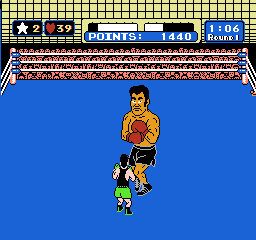
In my early twenties, I dabbled in boxing for about a year. I never fought any official bouts, but I did some training and fought a few practice fights. Since I’m 5’9” and have short arms, I got my ass handed to me. Boxing is a demanding sport, and you not only have to be in good shape, you have to be determined and mentally tough.
For the rest of us, there are games like Punch-Out.
Arguably one of the NES’s classic titles, Punch-Out began as an arcade game. The original was trimmed down and gently reworked into the NES cart we all know and (some of us) love. Punch-Out chronicles the story of Little Mac, a plucky little boxer with a good uppercut and an iron determination to make it to the top. The version most of us are familiar with is 1987’s Mike Tyson’s Punch-Out, which features the eponymous heavyweight legend as the final challenge. In 1990, the game was re-released without Iron Mike’s name attached, his place at the top filled by a character called Mr. Dream.

In either case, Mac must fight his way through three circuits: the Minor, Major, and World Circuits. Each is filled with a cast of bizarre but capable characters, ready to smash our little protagonist flat if he doesn’t have what it takes. My favorites are the tubby tyrant King Hippo and the flamboyant (and easily underestimated) Don Flamenco. Some of these fellas are in more than one circuit, and the second time you face them they will be fighting extra hard to put you down and regain their credibility.

Mac’s a pretty capable pugilist in his own right, but he’ll need your help. Anyone who’s played this game will tell you that timing is the key to success. As Big Trouble in Little China’s Jack Burton likes to say, “It’s all in the reflexes.” Your enemies will give you little clues and tip-offs when they’re about to go apeshit on you, and if you act fast and know what to do, you can pick through their defenses at those very moments and lay the hurt on. When you land particularly juicy punches, a little tone plays and a white star appears above your opponent’s head. These stars can be used to fire Mac’s devastating uppercut. The D-pad is used to move around, and you’ll need to do a lot of that. You can also block, but doing so saps a little of your stamina, which renders you a weak puppy if depleted fully. It comes back very slowly, so it’s better to try and fly like a butterfly and avoid getting stung entirely.

If someone’s white energy bar drops to nothing, they hit the mat. They then have a 10-count to get back up or they lose by KO. Another way to win a match is by TKO, which means a boxer has hit the mat thrice in one round of fighting. Fights can also be won by decision, although many of the later matches don’t give you this option. If you lose a non-title bout, you are given a rematch, but if you lose to a circuit champion you are knocked down a peg or two and have to work your way back up. Punch-Out is a little unforgiving, but then, so is real boxing!

The graphics and sound are pretty good, with the former outpacing the latter. The characters are illustrated in a charming and exaggerated way, not to mention the humor inherent in the size difference between Mac and his towering foes. The music is pretty stripped down, and there’s not a lot of it, but the tracks are memorable and convey the struggle of a boxer’s story pretty well.
Punch-Out was rehashed for the SNES in 1994 as Super Punch-Out, with a little more depth to the gameplay, and reappeared for the Wii in 2009. I really REALLY like the Wii version, which particularly deserves praise for its updated soundtrack. It is also brilliantly adapted for the Wii’s intuitive, movement-based play (although you can play it old school style if you want).
It takes a lot to be the champ, kid. Do you think you’ve got the stuff? There’s only one way to find out: pop that cartridge in, lace up your gloves, and get in the ring.




